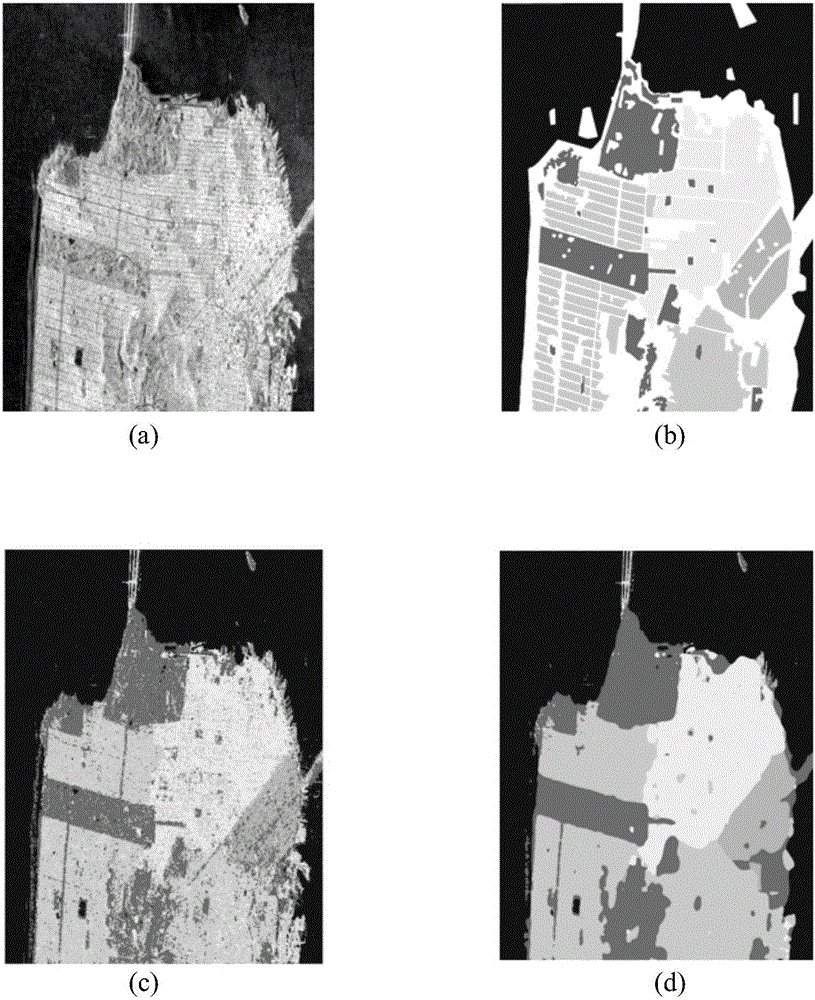Polarized SAR terrain classification method based on Gauss filtering and PSO
A Gaussian filtering and ground object classification technology, applied in the field of image processing, can solve the problem of low classification effect, and achieve the effect of improving the classification accuracy
- Summary
- Abstract
- Description
- Claims
- Application Information
AI Technical Summary
Problems solved by technology
Method used
Image
Examples
Embodiment 1
[0026] Example 1, classifying polarimetric SAR images in Germany.
[0027] The pseudo-color map of the polarimetric SAR image in Germany is shown in 2(a), and its size is 1300×1200;
[0028] The marker map of the polarized SAR image in Germany is shown in 2(b);
[0029] by false color figure 2 (a) The size of the obtained polarimetric SAR image is 1300×1200, from the marker figure 2 Randomly select 1% of the marked samples in (b) as training samples to obtain the category and location of the training samples, and use the remaining 99% of the labeled samples as test samples to obtain the category and location of the test samples. The total number of categories C is 3.
[0030] Using the existing single-pixel-based method SVM, according to figure 2 The polarimetric SAR data of (a) and figure 2 The labeled map in (b) is learned to classify the polarimetric SAR images in Germany, and the results are shown in 2(c).
[0031] Utilize the method of the present invention to cl...
Embodiment 2
[0051] Example 2, classifying polarimetric SAR images in the San Francisco area.
[0052] The pseudo-color map of the polarimetric SAR image in San Francisco is shown in 3(a), and its size is 1800×1380;
[0053] The marker map of the polarimetric SAR image in the San Francisco area is shown in 3(b);
[0054] by false color image 3 (a) The size of the obtained polarimetric SAR image is 1800×1380, from the marker image 3 Randomly select 1% of the marked samples in (b) as training samples to obtain the category and location of the training sample, and use the remaining 99% of the labeled samples as test samples to obtain the category and location of the test sample. The total number of categories C is 5.
[0055] Using the existing single-pixel-based method SVM, according to image 3 The polarimetric SAR data of (a) and image 3 The labeled map in (b) is learned to classify the polarimetric SAR images in the San Francisco area, and the results are shown in 3(c).
[0056] U...
Embodiment 3
[0072] Example 3, classifying polarimetric SAR images in the Netherlands.
[0073] The pseudo-color map of the polarimetric SAR image in the Netherlands is shown in 4(a), and its size is 750×1024;
[0074] The marked map of the polarimetric SAR image in the Netherlands is shown in 4(b);
[0075] by false color Figure 4 (a) The size of the obtained polarimetric SAR image is 750×1024, from the marker Figure 4 Randomly select 10% of the marked samples in (b) as training samples to obtain the category and location of the training sample, and use the remaining 90% of the labeled samples as the test sample to obtain the category and location of the test sample. The total number of categories C is 15.
[0076] Using the existing single-pixel-based method SVM, according to Figure 4 The polarimetric SAR data of (a) and Figure 4 The labeled map in (b) is learned to classify polarimetric SAR images in the Netherlands, and the results are shown in 4(c).
[0077] Utilize the metho...
PUM
 Login to View More
Login to View More Abstract
Description
Claims
Application Information
 Login to View More
Login to View More - R&D
- Intellectual Property
- Life Sciences
- Materials
- Tech Scout
- Unparalleled Data Quality
- Higher Quality Content
- 60% Fewer Hallucinations
Browse by: Latest US Patents, China's latest patents, Technical Efficacy Thesaurus, Application Domain, Technology Topic, Popular Technical Reports.
© 2025 PatSnap. All rights reserved.Legal|Privacy policy|Modern Slavery Act Transparency Statement|Sitemap|About US| Contact US: help@patsnap.com



